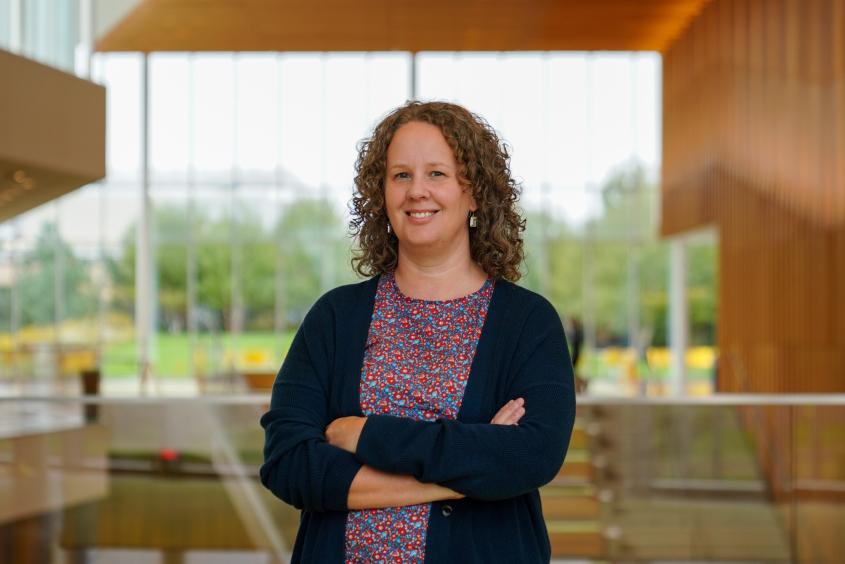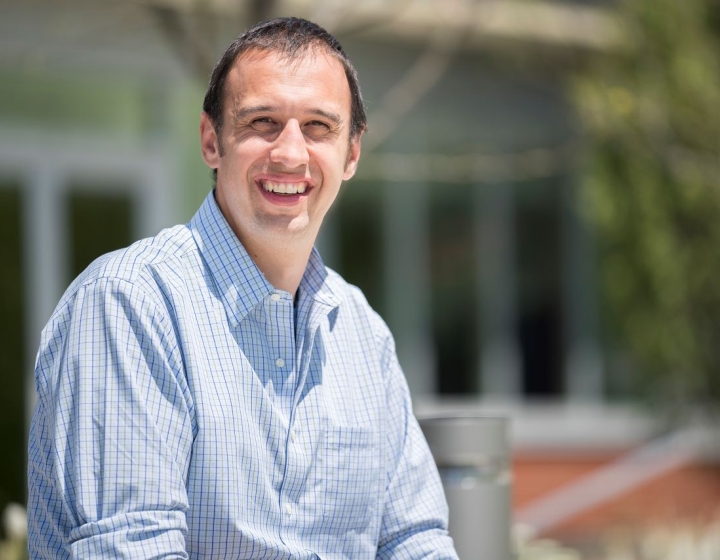New faculty: Dr. Mandy McGeachy
The Cornell University College of Veterinary Medicine (CVM) has recently welcomed many new faculty members to our academic departments and hospitals, each one bringing a unique set of skills and experience that enriches our college every day. In this Q&A series, you'll get to know their interests, expertise and more.
Dr. Mandy McGeachy, associate professor, Department of Microbiology and Immunology
Q: What has been your academic/career path leading up to Cornell?
I studied immunology at the University of Glasgow in Scotland, then completed my Ph.D. in Edinburgh studying regulatory T cells in a model of the autoimmune disease multiple sclerosis. As an undergraduate I spent a summer in the United States doing research and always wanted to return. So I looked for postdoctoral training opportunities in the United States and was most drawn by projects in the lab of Dr. Dan Cua. His group had just discovered a new subset of helper T cells called Th17 cells, and I found the research fascinating. Although all the other opportunities I looked at were in academia, Dan’s lab was at a company, Schering-Plough Biopharma. However, they had a great postdoc program and amazing resources, not to mention being based in Palo Alto, California, so I decided to go for the industry postdoc. It was a superb experience and I was fortunate to be hired as a senior scientist in Dan’s group. However, as my job migrated more towards the industry side of working in biopharma, I had a decision to make: my resume was still suitable for a faculty position in academia but not if I waited too long. So I decided to apply for faculty positions and happily the University of Pittsburgh was willing to take a chance on someone without any current funding or experience of writing grants.
With wonderful mentorship and collaborators I established my research program and obtained funding to support it. The immunology community at Pittsburgh grew from strength to strength, and it was a fun and stimulating environment to grow my lab and research. After ten years, and with the pandemic to sharpen focus, it was time for a change and the many draws of the opportunity to be part of and support the growing Department of Microbiology and Immunology at Cornell led to me moving my lab and family to Ithaca in summer of 2022.
Q: What drew you to CVM?
Many things: new collaboration opportunities; the growing immunology community and chance to contribute to a culture that supports researchers from all backgrounds; the new Department of Microbiology and Immunology chair, Dr. Deb Fowell, one of a small but thankfully growing number of female chairs in our field; a return to my veterinary roots in perhaps the right capacity (on the science side instead of clinical); Ithaca and the opportunity to move my family to a beautiful part of the country!
Q: What is your scientific area of expertise?
My lab studies Th17 cells and their major product IL-17. Th17 cells are known for pathogenic roles in autoimmune and inflammatory disease, and IL-17 blockers are very effective in treating psoriasis. Th17 cells are also present in healthy individuals at barrier surfaces (e.g. skin, gut) where they provide critical regulation of the resident microbiota and protect against pathogenic bacterial and fungal infections, often without causing obvious inflammation. We are starting to appreciate new roles for IL-17 in tissue repair and proliferation of epithelial and stromal cells that could promote or repair cancer and fibrosis depending on context. We are interested in dissecting these damaging versus healthy outcomes of IL-17 signaling and how Th17 cells are programmed to be either pathogenic or helpful, with a view to manipulating the pathway for therapeutic applications.
Q: What drew you into this area? Any specific experiences, mentors, influences that helped guide you?
I am most drawn to the unexpected results that challenge dogma, and the discovery of Th17 cells is a great example. Many studies had shown important roles for a protein named IL-12 in mouse models of autoimmune disease. However, IL-12 has two subunits, and the work was based on genetic or antibody-mediated blockade of one subunit, p40. It turned out that p40 is also used by another protein, IL-23, and when the unique subunits of IL-12 and IL-23 were each blocked the data showed that they have separate functions and in fact IL-23 is the critical driver of autoimmune disease. This led to further analysis of how IL-12 and IL-23 affect their target cell, T cells, and the discovery that IL-23 promotes Th17 cells, a new subset described in 2005 right as I was looking for postdoc training opportunities. I was incredibly fortunate to be hired by Dr. Dan Cua at DNAX/Schering Plough Biopharma to work on IL-23 and Th17 cells as this new field of research blossomed. It was very exciting. When I set up my own lab at the University of Pittsburgh I was again fortunate to work alongside one of the masters of IL-17 signaling, Dr. Sarah Gaffen, who was not only a fantastic mentor but remains a fantastic collaborator on all things IL-17 related.
Q:What about your work are you most excited for/proud of and why?
I am proud of all of our papers, published by different graduate students and postdocs over the years. Currently our lab is excited about new directions in studying Th17 cells and effects in lymph nodes, where adaptive immune responses such as antibody production, are initiated. We are finding unexpected functions for IL-17 in modulating these immune responses to improve antibody production – which could have implications for vaccine design - and in regulating T cell exhaustion and activation – which could have implications for chronic infection and cancer. In addition, we are working to optimize our models to study T cell activation in a more human-relevant way in our mouse models. In future, I am hoping to incorporate studies in new (to us) species such as horses and dogs where the effects of IL-17 have not been extensively studied yet.
Q: What impacts or applications do you hope to see your work have on the human/animal health?
We are interested in understanding how Th17 cells and IL-17 are driven to be either beneficial or damaging, with the idea that these can be optimized for therapeutic applications ranging from autoimmune disease and cancer to improving vaccine adjuvants.
Q: What’s something most people don’t know about you?
I started my academic career as a veterinary medicine student at the University of Glasgow, Scotland. Having grown up reading James Herriot, loving animals and collecting bugs that I found in our garden in South Africa, my dream was to be a vet by day and author by night. However, I soon realized I was more interested in the science and didn’t enjoy clinical medicine, so after three years I took the intercalated program option to go do a Bachelor of Science degree (in the United Kingdom vet med is a first degree unlike the United States). My advisor suggested immunology since it has applications to every body system and disease in some capacity, and Glasgow has an excellent two-year immunology honors course that included help to organize a summer research internship in the United States – this appealed to me and turned out to be life changing as I fell in love with the immune system and decided to pursue my Ph.D. and a career in research.
Q: What’s the best part of being a scientist?
Constant learning and the freedom to be curious and explore new ideas.
Q: What’s the most challenging part?
There is so much new knowledge being generated, especially with rapidly evolving new technologies and ‘big data’, it is such an exciting but sometimes overwhelming time in science. Sometimes I wish I could install extra processing speed and memory capacity in my brain!
Q: What are the benefits of working at CVM? At Cornell?
I enjoy being part of a wider community that cares about scientific innovation as a means to improve health care in animals and humans, and the supportive environment that the college and university provides to do research. I am not a big-city person, so I personally feel happier in the more natural setting of the Cornell campus and surrounding area. Hopefully this translates to a happy and productive lab too, watch this space!






